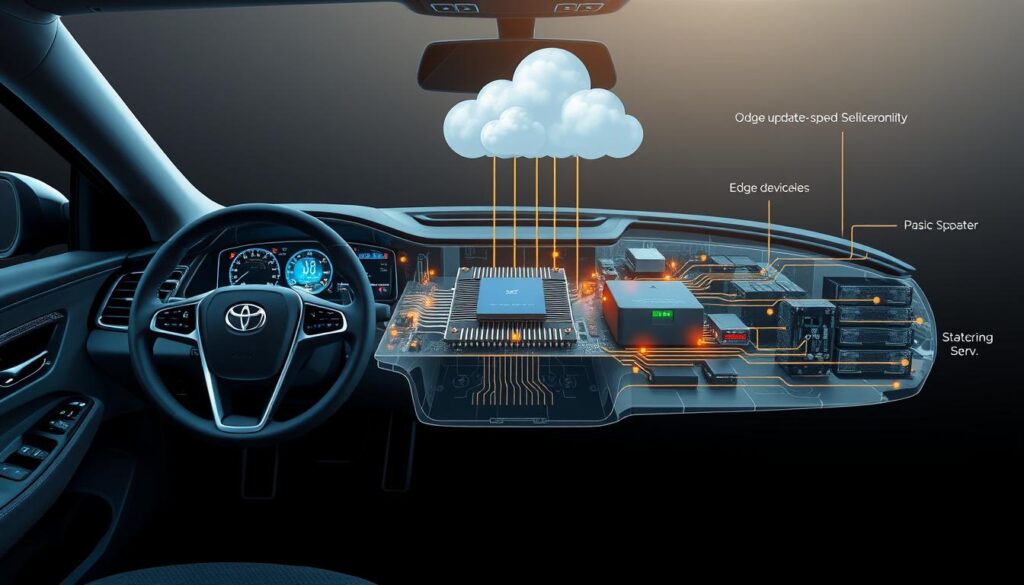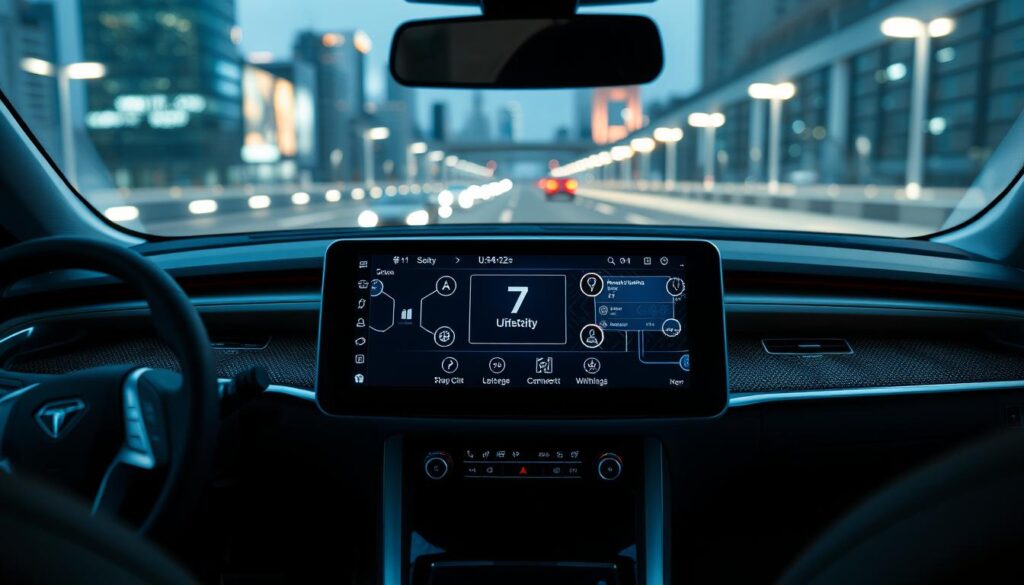One rainy night, a fleet manager tapped a notification on her phone and rolled out a critical security fix to cars parked across town. She watched progress bars climb while drivers slept, and by morning the fleet ran smoother with no dealership visits.
Cloud-powered update systems now link mobile apps, BLE modules, and secure firmware pipelines so teams can deliver new features and fixes without costly recalls. Modern automotive systems rely on networks of ECUs and ADAS, and software faults drove over 13 million recalls in 2024.
That rise in software recalls makes a proactive release strategy essential. With the right cloud orchestration, manufacturers can push firmware updates and software safely, using smart air choices like Wi‑Fi or 5G to balance cost and speed.

Iottive offers end-to-end solutions for BLE app development, cloud integration, and secure pipelines to help teams ship faster and protect brand trust.
Key Takeaways
- Cloud delivery lets teams fix software and add new features without dealer visits.
- Continuous firmware updates reduce recall exposure and protect reputation.
- Secure pipelines and rollback plans are critical for safety and compliance.
- Choosing the right air link (Wi‑Fi vs cellular) shapes cost and timing.
- Iottive provides end-to-end design and integration for reliable update programs.
Why Autonomous Vehicles Depend on Cloud-Based Updates for Security and Efficiency
As cars shift from hardware-first to software-led designs, cloud orchestration becomes the backbone of reliability and safety.
Software-defined vehicles now house 100+ ECUs and tens of millions of code lines. That scale means manufacturers need centralized management to keep systems aligned across suppliers and model years.
Cloud delivery makes continuous software updates possible. Instead of rare IVI patches once a year, fleets receive faster fixes for security gaps and feature improvements. This reduces time-to-fix for vulnerabilities and shrinks exposure windows for cybersecurity threats.
Benefits for manufacturers include coordinated rollouts, version visibility across fleets, and rollback controls that protect safety-critical modules.
The owner experience and safety payoff
Drivers get unobtrusive, smartphone-like update flows that add new features and improve reliability without dealership trips. Clear communication builds trust and turns recall anxiety into steady product improvement.
- Centralized visibility for coordinated releases
- Rapid delivery of security and firmware fixes
- Roadmaps that plan years of support across components
Iottive‘s end-to-end cloud & mobile integration helps automotive manufacturers operationalize SDV strategies for uptime, safety, and new features. Contact: www.iottive.com | sales@iottive.com.
AV OTA updates, IoT vehicle patching, AI performance tuning
Modern automotive fleets rely on remote delivery to keep software and control code current.
Definitions: An ota update is the remote delivery of both application code and firmware to on‑board systems. FOTA refers specifically to firmware updates for embedded controllers and low‑level parts that control sensors, brakes, and powertrain.
Layer distinctions: Application software adds features and user experience changes. Firmware governs hardware behavior and safety‑critical control. Both are needed to reduce vulnerabilities and preserve system stability.

What real-world patching covers
IoT vehicle patching maps to orchestration across ECUs, telematics units, gateways, and edge devices. Teams manage signed packages, versioning, and staged rollouts so limited memory or compute on ECUs won’t fail during install.
Architectures and delivery
Pick Edge‑to‑Cloud for direct installs, Gateway‑to‑Cloud when a central unit coordinates local parts, or Edge‑Gateway‑Cloud when gateways distribute compressed, delta firmware packages. Incremental updates cut air bandwidth and lower delivery cost.
Model and runtime work
AI performance tuning includes model refreshes, validation on fresh data, and compact runtime builds for sensor fusion and planning modules. Development pipelines must sign artifacts, run integrity checks, and support quick rollback for safety.
Iottive designs and integrates secure FOTA/ota flows, BLE app development, and cloud & mobile integration to scale patching from gateways to edge devices. Contact: www.iottive.com | sales@iottive.com.
The Recall Reality: Costs, Risks, and How OTA Reduces Exposure
Today’s recalls demand faster, more surgical responses than ever before.
Recall events carry clear line-item costs and hidden fallout. Hardware fixes can run $500–$2,000 per car, while software remedies often cost $300–$500. Add brand damage, scheduling bottlenecks, and regulatory fines—like the $130M penalty for late reporting—and totals climb quickly.
In 2025, 3.5 million U.S. vehicles were recalled across 197 issues. Rapid, cloud-driven delivery compresses fixes from weeks or months to days or hours. That speed shrinks exposure to vulnerabilities and improves owner experience.
Turning recalls into controlled responses
Staged rollouts begin with a small canary group, monitor telemetry data, and expand only when metrics look healthy. This approach limits risk and cuts time-to-remediation for software defects.
Delivering firmware updates and software update packages over the air eases service-center load. Technicians can then focus on hardware repairs, reducing dealer backlog and customer inconvenience.
| Impact | Traditional Recall | Cloud Staged Rollout |
|---|---|---|
| Per-unit cost | $500–$2,000 | $300–$500 (software) |
| Time to fix | Weeks–Months | Hours–Days |
| Service load | High — dealer visits | Lower — remote delivery |
| Regulatory reporting | Complex, slow | Auditable, fast |
Management and orchestration tie engineering, support, and field teams to a single plan. Clear audit trails and campaign versions simplify reporting and limit penalties.
Iottive helps automotive manufacturers accelerate secure delivery, auditing, and staged deployments so service centers stay focused and owners stay informed. www.iottive.com | sales@iottive.com.
Inside the Stack: How Vehicle OTA Works from Edge to Cloud
A reliable update pipeline starts with choosing the right architecture for each fleet mix. Edge-to-cloud lets endpoints pull packages directly. Gateway-to-cloud updates a central unit that then distributes to local modules. Edge-gateway-cloud combines both for constrained networks.

Architectures compared
Pick direct delivery when connectivity is consistent and units can verify large payloads. Use gateway-mediated patterns where bandwidth, caching, or local coordination matter.
Data flows and orchestration
Packaging, signing, and policy targeting happen in the cloud. Schedules control download windows over air interfaces. Install, validation, and telemetry return to management dashboards for rollbacks or confirmations.
Why these systems differ from phones
Vehicles host many ECUs from multiple suppliers. That creates compatibility and safety constraints that demand strict version control and A/B partitioning to avoid bricking modules.
Iottive’s Cloud & Mobile Integration and Custom IoT Products teams architect Edge-to-Cloud and Gateway patterns to ensure dependable orchestration, versioning, and telemetry across fleets. www.iottive.com | sales@iottive.com.
Advanced OTA Capabilities Built for Automotive
A safe update program combines partitioning, delta delivery, and tight version control to reduce risk.
Iottive implements A/B partitioning, delta delivery, and whole-vehicle configuration management as part of end-to-end solutions. These capabilities preserve drivability while shrinking delivery windows.

A/B partitions and instant rollback
A/B partitions keep one bootable image while a second image installs. If post-install checks fail, the system flips back instantly to the known-good image.
This design prevents bricking and preserves control of critical hardware during a failed install.
Delta delivery and compression
Delta updates send only changed bytes between versions. Compression cuts gigabyte payloads to manageable sizes.
Smaller transfers reduce airtime, cost, and the overall time customers wait for new features or firmware fixes.
Configuration management and staged rollouts
Software configuration management synchronizes versions across ECUs so interdependent systems remain compatible.
Staged rollouts and canary fleets validate real‑world behavior before broad promotion, using metrics gates for safety.
| Capability | Benefit | Key Check |
|---|---|---|
| A/B Partitioning | Instant rollback; avoids bricking | Post-install boot health |
| Delta & Compression | Lower bandwidth; faster delivery | Checksum & delta validation |
| Config Management | Whole-system reliability | Version compatibility matrix |
| Staged Rollouts | Controlled risk; measurable gates | Telemetry and canary metrics |
Reliability, logging, and security
Preflight validation, power-state checks, signature verification, and post-install health signals mark success. Throttling, backoff, and resumable downloads improve completion rates.
Comprehensive audit logs record versions, timestamps, and outcomes for analysis and regulatory readiness. End-to-end signature checks defend against tampering and preserve trust.
Iottive ties these features into turnkey delivery so owners get seamless background enhancements and teams retain firm control and traceability. www.iottive.com | sales@iottive.com.
Connectivity Choices: Wi‑Fi vs Cellular for Time-Sensitive and Large Updates
Choosing the right link for delivery changes how fast and cheaply a fix reaches cars on the road.

Teams must match urgency to channel. Use cellular for critical fixes that need immediate delivery. Reserve Wi‑Fi for big, nonurgent packages like maps or infotainment feature bundles.
When to use cellular versus Wi‑Fi
Cellular provides reach and predictable time-to-delivery for urgent software and firmware fixes.
Wi‑Fi offers higher throughput and lower cost for bulk delivery of new features and data-heavy packages.
Managing costs, networks, and user experience
- Cost controls: enforce bandwidth caps, schedule downloads off-peak, and prefer opportunistic Wi‑Fi when available.
- User experience: give clear prompts, flexible scheduling, and resume downloads when coverage returns.
- Network tradeoffs: cellular wins for timeliness; Wi‑Fi wins for bulk and lower carrier fees.
| Package Type | Preferred Link | Key Control | Risk Mitigation |
|---|---|---|---|
| Urgent security fix | Cellular (LTE/5G) | Immediate rollout; throttles | Resumable downloads; integrity checks |
| Large feature release | Wi‑Fi | Scheduled off-peak delivery | Delta delivery; prefetching |
| Map/IVI data | Wi‑Fi preferred | Background prefetch | Checksum validation; encryption |
| Mixed-priority fleets | Hybrid (dynamic switch) | Telemetry-driven policy | Geo-segmentation; carrier-aware rollouts |
Iottive helps teams design connectivity policies that balance cellular and Wi‑Fi, protect data in motion, and minimize driver friction. www.iottive.com | sales@iottive.com.
EV vs ICE: Practical Differences in Performing OTA Updates
Electric cars often let engineers run full-system installs while parked, which changes how teams schedule remote fixes. EV architectures can keep many systems powered without the engine, so large packages install while the car charges. That reduces user effort and shortens the window for intervention.

Power states, update windows, and why EVs enable smoother OTA
EVs provide stable power and often maintain thermal and control systems while plugged in. This makes long installs and integrity checks safe.
ICE platforms usually limit accessory power. Some modules won’t stay active unless the engine runs. That demands shorter installs or user involvement.
Designing update experiences drivers actually complete
Human-centered flows boost completion rates. Tie scheduling to charging or parking events, and prompt drivers via companion apps for consent and progress.
- Use small bundles during short idle windows for ICE cars.
- Deliver larger firmware packages when EVs are plugged in with Wi‑Fi.
- Verify power and connectivity before install and confirm post-install health before returning control.
Safety first: never run critical system installs while the car is in motion. Telemetry should inform smarter schedules so recommendations match real driver habits.
Iottive consults on human-centered update flows—scheduling, prompts, and mobile app tie-ins—to increase completion across EV and ICE fleets. www.iottive.com | sales@iottive.com.
From Safety to Speed: AI Performance Tuning and ADAS/AV Model Updates
Model refresh cycles now shape how quickly driver assistance can adapt to new roads and weather.
Model lifecycle starts with fleet data collection and automated drift detection. Teams validate candidates in shadow mode before any live deployment.
Validation and staged delivery
Safety first: rollouts begin small, with strict thresholds for false positives, latency, and handoff stability. Rapid rollback paths protect drivers if metrics degrade.
“Shadow testing and canary fleets turn research models into dependable on-road features.”
Edge constraints and packaging
Perception and fusion modules need compact runtimes for limited compute and memory. Packaging includes versioned dependencies so systems can revert cleanly when needed.
- Monitor post-deploy telemetry: latency, false alarms, handoff events.
- Sign and verify model packages for strong cybersecurity and integrity.
- Coordinate model, firmware, and software releases to avoid compatibility gaps.
Result: safer enhancements, better detection in poor weather, and smoother control that drivers notice. Iottive’s AIoT expertise supports safe model delivery, packaging ML artifacts, validating performance, and coordinating rollbacks for ADAS and autonomy. www.iottive.com | sales@iottive.com.
Security, Compliance, and Failure Management in Automotive OTA
Secure delivery hinges on cryptographic controls, clear policies, and tested recovery paths.
End-to-end encryption, artifact signing, and integrity checks form the core defenses. Encrypt data in transit and at rest, sign each software and firmware package, and verify checksums before install. These steps block tampering and preserve trust.
Regulatory readiness and audit trails
Maintain complete logs of timestamps, version changes, and install outcomes. Automated reports support investigations and limit liability.
Failure playbooks and recovery
Design resumable downloads, safe states, and A/B partitions so systems can revert without loss of drivability. Define clear service-center handoffs when manual repair is needed.
- Policy controls: target only authorized recipients to limit blast radius.
- Key management: rotate certificates and run continuous vulnerability scans.
- Operational controls: separate duties and apply least-privilege access.
- Communications: provide owner notices that explain what changed and why.
| Control | Benefit | Key Check |
|---|---|---|
| Encryption & Signing | Stops tampering; ensures integrity | Signature verification pre-install |
| Audit Trails | Speeds reporting; limits liability | Comprehensive timestamped logs |
| Failure Playbook | Faster recovery; fewer service visits | Resumable downloads; A/B rollback |
| Key Rotation | Keeps trust chain current | Automated certificate expiry checks |
Iottive builds secure-by-design pipelines with encryption, signing, audit logging, and recovery mechanisms aligned to compliance and liability needs. www.iottive.com | sales@iottive.com.
How Iottive Helps: End-to-End IoT/AIoT/Smart Solutions for Vehicle Updates
Iottive turns complex firmware pipelines into reliable delivery channels for manufacturers. We plan, build, and operate secure update programs that span endpoints, gateways, and cloud services. Our approach reduces time-to-fix and improves owner experience with clear communications and dependable installs.
Our expertise
IoT & AIoT Solutions, BLE App Development, Cloud & Mobile Integration, Custom IoT Products
- End-to-end delivery: architecture choices (Edge-to-Cloud, Gateway-to-Cloud, Edge-Gateway-Cloud) and staged rollouts.
- BLE app work: companion apps that drive intuitive consent, scheduling, and reliable confirmation flows.
- Custom products: firmware and systems integration that keeps mixed hardware dependable across fleets.
Industry focus
We serve Healthcare, Automotive, Smart Home, Consumer Electronics, and Industrial IoT. Cross-domain best practices inform safer, faster rollouts for automotive programs.
Delivery, security, and model support
We emphasize delivery excellence: telemetry-driven targeting, canary groups, and data-informed improvements after each release.
Security-by-design is embedded from day one—encryption, signing, audit logging, and robust recovery strategies protect systems and compliance needs.
“A staged rollout with telemetry gates turns risk into measurable progress.”
| Capability | Benefit | How we verify |
|---|---|---|
| Staged rollouts & telemetry | Lower blast radius; faster remediation | Canary metrics and automated gates |
| Delta delivery & A/B partitions | Faster installs; instant rollback | Checksum validation and boot health checks |
| Model packaging & validation | Safer model refreshes for ADAS systems | Shadow testing and rollback thresholds |
Result: manufacturers get measurable reductions in time-to-fix, higher install completion, and a path to deliver new features and firmware safely at scale.
Partner with a trusted team: Iottive provides tailored solutions and hands-on development to bring secure software updates and enhancements to life. Contact us: www.iottive.com | sales@iottive.com
Conclusion
Cloud-driven delivery compresses fix timelines so fleets recover in days, not weeks. This lowers recall cost and gets new features into owners’ hands with minimal disruption.
Reliable programs combine firmware resilience, staged rollouts, strong security, and precise orchestration across components. Proper version discipline prevents compatibility gaps and preserves drivability.
Automotive manufacturers that operationalize remote update programs cut costs, protect brand trust, and move faster than competitors. Use a mixed air strategy—cellular for urgent fixes and Wi‑Fi for bulk packages—to balance speed and cost.
Iottive can help you plan, pilot, and scale a secure, reliable ota program—from strategy to deployment. Contact our experts to scope goals for install success, time-to-install, and owner satisfaction. Thank you. www.iottive.com | sales@iottive.com.
FAQ
What is a cloud-based update system for autonomous vehicles and why does it matter?
A cloud-based update system delivers software and firmware changes from a centralized platform to distributed cars. It matters because it keeps driving systems secure, fixes bugs quickly, and adds features without dealership visits. This approach improves uptime, reduces recalls, and helps manufacturers respond fast to safety issues.
How do continuous updates change the ownership experience compared to traditional recalls?
Continuous updates let manufacturers push fixes and improvements over the air, minimizing the need for physical recalls. Owners get new features and safety patches faster. That reduces downtime and lowers costs while improving overall reliability and customer satisfaction.
What’s the difference between OTA, FOTA, and general software updates in cars?
OTA (over-the-air) is the general term for wireless delivery of software. FOTA (firmware-over-the-air) specifically updates low-level firmware on ECUs and modules. General software updates cover apps, middleware, and higher-level vehicle functions. Each targets different components and has distinct safety and validation needs.
What does vehicle patching cover across ECUs, gateways, and edge devices?
Patching spans electronic control units (ECUs), domain gateways, telematics units, and edge compute nodes. It includes firmware fixes, security patches, driver updates for sensors, and configuration changes. Proper orchestration ensures compatibility across suppliers and prevents system conflicts.
How is machine learning tuned and deployed safely over the air?
ML model updates require dataset validation, simulated testing, and staged rollouts. Teams validate models for drift, run A/B comparisons, and deploy to canary fleets first. Rollback mechanisms and integrity checks ensure models can be reverted if performance degrades in real-world conditions.
How do staged rollouts and canary fleets reduce recall risk?
Staged rollouts let teams release updates to a small subset of vehicles, monitor telemetry, and catch regressions before broad deployment. Canary fleets act as early detectors for issues. This approach converts big, risky recalls into controlled, data-driven responses.
What are the common architectures for update delivery from edge to cloud?
Common patterns include direct edge-to-cloud, gateway-to-cloud, and hybrid edge-gateway-cloud. The choice depends on latency, bandwidth, supplier topology, and safety constraints. Hybrid models help distribute validation and reduce single points of failure.
Why are cars different from smartphones when it comes to software delivery?
Cars include multiple safety-critical ECUs, long vehicle lifecycles, and supplier diversity. Deliveries must account for real-time constraints, hardware variation, and strict safety standards. This complexity requires more rigorous validation and auditability than consumer devices.
What features prevent bricking and ensure reliable installs?
A/B partitioning, atomic installs, and instant rollback protect against bricking. Delta updates, checksums, and staged verification help ensure installs complete successfully. Combined, these features maintain availability even during failed updates.
How do delta updates and compression help with large fleets?
Delta updates send only changed bytes instead of full images, greatly reducing payload size. Compression and patch optimization lower bandwidth use and cost. This makes frequent updates feasible across large fleets without overloading networks.
Which connectivity option is best for time-sensitive safety patches: cellular or Wi‑Fi?
Use cellular (LTE/5G) for urgent safety patches when immediate reach is critical. Wi‑Fi works for large feature updates and nonurgent payloads to save mobile data. Most manufacturers employ a policy that prioritizes critical fixes over cellular and schedules big downloads for Wi‑Fi.
How do power state differences between EVs and ICE cars affect update windows?
EVs can often provide stable power during updates and support longer maintenance windows, enabling smoother installs. ICE vehicles may have more restricted power availability, so updates often occur while the engine runs or during service visits. Update scheduling must account for these differences.
How are AI and ADAS model updates validated before deployment?
Validation includes backtesting on labeled datasets, closed-loop simulation, real-world shadow testing, and metric thresholds for safety and performance. Teams use validation gates, canary testing, and telemetry monitoring to ensure models meet safety and reliability standards before wider rollout.
What security measures protect update integrity and prevent tampering?
Secure update chains use end-to-end encryption, cryptographic signatures, and hardware-backed root of trust. Integrity checks, certificate pinning, and strict key management prevent unauthorized images. Audit logs and attestation help demonstrate compliance.
How do manufacturers handle audit trails and regulatory reporting for software delivery?
They maintain comprehensive logs of version history, deployment timestamps, and device acknowledgments. Systems generate reports for regulators showing provenance, test results, and rollback actions. This traceability supports liability protection and compliance audits.
What happens if an update fails mid-install?
Modern systems support resumable downloads, automatic rollback to a safe partition, and diagnostic logging for service centers. Failure playbooks define next steps: retry logic, user notifications, and, if needed, a service-center handoff with detailed fault data.
How can a company like Iottive help with whole-vehicle update programs?
Iottive offers end-to-end solutions including cloud integration, secure delivery pipelines, and edge software design. They bring experience in embedded firmware, mobile and cloud integration, and industry-specific compliance to reduce risk and accelerate deployments.
How do teams manage costs and user experience during large downloads?
Teams combine delta updates, scheduled Wi‑Fi windows, and user notifications to avoid surprise data charges. They monitor network costs, prioritize essential patches, and optimize UX to ensure drivers understand and complete updates.
Where can I learn more or request support from Iottive?
Visit www.iottive.com or email sales@iottive.com to discuss integration, security, and deployment strategies for connected cars. Their team can advise on cloud pipelines, embedded design, and fleet-scale delivery plans.